In art there are many curiosities, we will periodically share their stories
The garden of delights
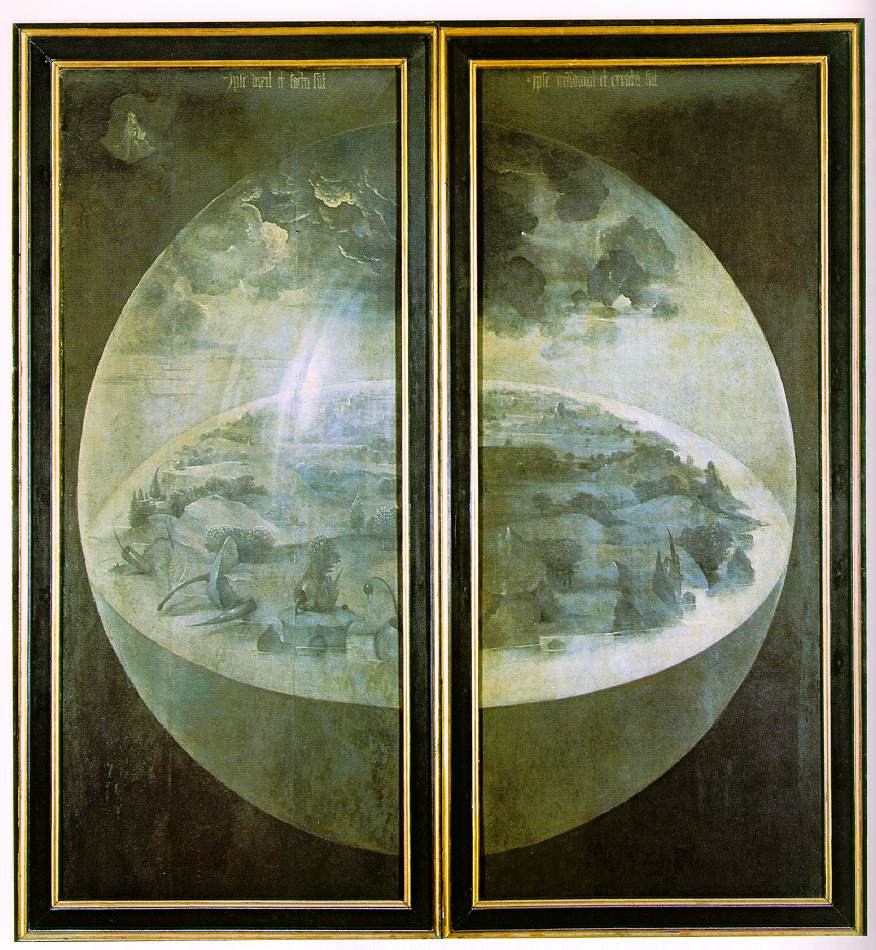
The painter Hieronymus Bosch is the creator of this beautiful work of art, it is curious because it is the painting with the most characters in a work of this style.
The work is painted in oil on a central table of 220 x 195 centimeters and two sides of 220 x 97 centimeters each on both sides with a total of 389 centimeters
In this triptych there are more than 450 people as well as a great variety of real and fictitious animals.
Open triptych
When opened, the triptych presents, in the left panel, an image of paradise where the last day of creation is represented, with Eva and Adam, and in the central panel the madness unleashed is represented: lust. In this central table the sexual act appears and it is where all kinds of carnal pleasures are discovered, which are the proof that man had lost grace. Finally we have the table on the right where the sentence in hell is represented; in it the painter shows us a tremendous and cruel scenario in which the human being is condemned for his sin.
The structure of the work, itself, also has a symbolic frame: when it opens, it really closes symbolically, because its content contains the human beginning and end. The beginning in the first table, which represents Genesis and Paradise, and the end in the third, which represents Hell.
Closed triptych
The box closed on the outside refers to the third day of the creation of the world. A globe is represented, with the Earth inside a transparent sphere, symbol, according to Tolnay, of the fragility of the universe. There are only vegetable and mineral forms, there are no animals or people. It is painted in gray, black and white tones, which corresponds to a world without the Sun or Moon, although it is also a way to achieve a dramatic contrast with the interior color, between a world before man and another populated by infinity of beings (Belting).
Traditionally, the image showing the closed triptych has been interpreted as the third day of creation. The number three was considered a complete number, perfect, since in itself it contains the beginning and the end. And here, when closed, it becomes, in number one, the circle: once again it allows us to glimpse absolute perfection and, perhaps, the divine trinity. In the upper left corner, a small image of God appears, with a tiara and the Bible on his knees. At the top you can read the phrase, taken from Psalm 33, IPSE DIXIT ET FACTA S (U) NT / IPSE MAN (N) DAVIT ET CREATA S (U) NT, which means «He said it, and everything was done . He sent it, and everything was created ». Others interpret that it could represent the Earth after the Universal Flood.
Left panel: The Garden of Eden
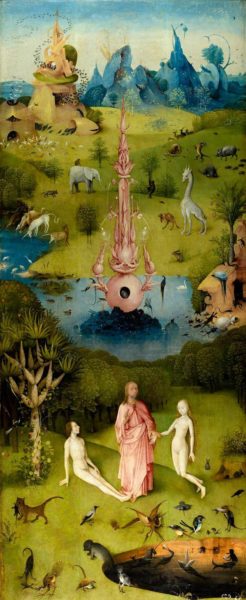 In the background you can see the Fountain of Life. In the foreground is a completely atypical scene since it does not represent either Eve’s creation from Adam’s rib, nor the way of behaving in the garden, nor the counterclaim that follows the expulsion from paradise, the only themes reported in the Genesis in relation to this episode. In this curious and original scene God, Eve and Adam appear. Adam is awake, which only appears in miniatures, and God is introducing him to newly created Eve. God is represented in an old-fashioned way for Bosco times: like Jesus Christ. Eva is kneeling on the ground and holding God’s hand. Adam, lying down, looks at the future sinner. Next to the first man and the first woman appears the Tree of life (an exotic dragon tree), and in the background, on the right, the Tree of good and evil (a palm tree, also called the tree of science), as around him the tempting serpent coils. Since a lustful world is represented in the next panel, this table has been interpreted as the prelude to what will happen next.
In the background you can see the Fountain of Life. In the foreground is a completely atypical scene since it does not represent either Eve’s creation from Adam’s rib, nor the way of behaving in the garden, nor the counterclaim that follows the expulsion from paradise, the only themes reported in the Genesis in relation to this episode. In this curious and original scene God, Eve and Adam appear. Adam is awake, which only appears in miniatures, and God is introducing him to newly created Eve. God is represented in an old-fashioned way for Bosco times: like Jesus Christ. Eva is kneeling on the ground and holding God’s hand. Adam, lying down, looks at the future sinner. Next to the first man and the first woman appears the Tree of life (an exotic dragon tree), and in the background, on the right, the Tree of good and evil (a palm tree, also called the tree of science), as around him the tempting serpent coils. Since a lustful world is represented in the next panel, this table has been interpreted as the prelude to what will happen next.
In what at first glance seems the typical Eden, associated with the idea of peace and tranquility, with little to observe, that idyllic setting is truncated. Various signs of harassment break out, the animals confront each other: a lion knocks down a deer and prepares to eat it, a strange biped is chased by a boar. In the pond, disputes between animals resume again: a leopard carries a mouse in its mouth, a bird devours a frog. They are foreign signs to the paradisiac peace that are usually interpreted as a warning of sin.
-Female sin is personified in the bichejos that crawl through the earth (insects and reptiles) or swim through the water (amphibians and fish), since, of the Four elements (earth, water, fire and air), the earth and the water were considered passive essences full of fertility that, like the woman, receive the seed.
-Men’s sin is represented by the vermin that fly (flying insects, birds, bats …), since air is considered an active element, associated with fire and opposite to the earth, therefore, masculine.
-The devil is hidden in the ponds and rocks that are, for Bosco, the den of evil spirits. For example, in the source of life we see a structure between mineral and organic, with a hole through which an owl appears, an explicit symbol of malice, which also appears in The Hay Wagon. It is possible that this architectural element, similar to an arrow of a cathedral, in the center of the painting, is a phallic symbol advocating the pleasures of meat on the central table. To his right, “a rock whose shape is the hidden face of the Devil”, from which the serpent that coils to the Tree of forbidden fruit arises. The strange contours of those rocky mountains in the background indicate a possible disturbance of the peaceful coexistence.
Real, but extremely exotic, animals appear in the work in the time of Bosco, such as giraffes, elephants, lions, leopards, when Africa was practically unknown in Europe. The author could only have reference to these beasts through the medieval mythological bestiaries (which he undoubtedly exceeded) and the drawings that began to circulate thanks to the printing press, especially those with Egypt as the main theme.
The work presents an intense and varied color scheme. The green and intense blue of the background predominate, contrasting with the red cloak of God and the whiteness of the bodies of Adam and Eve.
Center panel: The Garden of Earthly Delights
 A false paradise in which humanity has already fully succumbed to sin, especially lust, and is heading for its doom. Dozens of different symbols, whose keys can only be suspected, populate this oppressive and anguished space in which madness has taken over the world. Both men and women appear, black and white, naked. All kinds of sex and erotic scenes are shown, mainly heterosexual, but also homosexual and onanistic. In addition, erotic or sexual relationships also appear between animals, and even between plants.
A false paradise in which humanity has already fully succumbed to sin, especially lust, and is heading for its doom. Dozens of different symbols, whose keys can only be suspected, populate this oppressive and anguished space in which madness has taken over the world. Both men and women appear, black and white, naked. All kinds of sex and erotic scenes are shown, mainly heterosexual, but also homosexual and onanistic. In addition, erotic or sexual relationships also appear between animals, and even between plants.
This is the traditional interpretation of the central panel. However, there have been others that deviate from it, considering that Bosco does not really condemn what is being seen in this panel, on the contrary, it seems a positive world, highly “desirable”. A universe of happiness is represented, without pain, disease or death. The passage of time is not represented (there are no children or old people), nor is anyone seen working to earn a living with the sweat of their forehead. A diverse humanity is described that feeds on the fruits of the earth and is organized in natural structures. For this reason, W. Fraenger believed that he saw in the work an illustration of the religious conceptions of the heretical sect of the Adamites, a thesis that today is not accepted. Paul Vandenbroeck (2001) has argued that the Mountain of Venus (3rd Grail), known at the end of the medieval period as the “false paradise”, is represented here, although as traditional theses he understands it to be “sinful and demonic”. Instead, Juan Antonio Ramírez defends that what is really being represented, given that there is a continuity of the landscape in relation to the table on the left, an illustration from Genesis. The earthly Paradise would be described, according to Genesis.
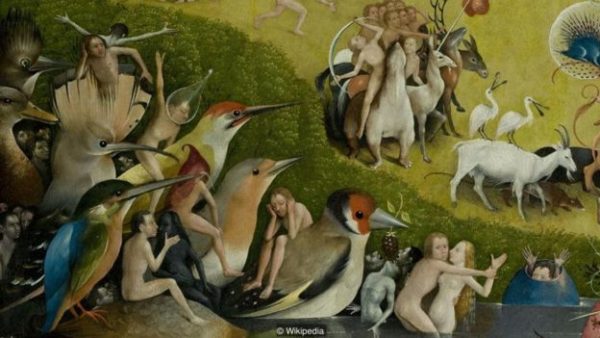 In the Bosco painting you can see, in effect, all kinds of fruits and trees, as well as, at the top, the four rivers of Paradise, including Pisón, with a construction with strange golden flowers and Geón with a colony of monkeys, and the other two rivers alluding to the rivers of Mesopotamia. Paradise would be represented as, according to Christianity, God created it, but not as the place where Eve sinned, but as the ideal paradise, the one that should have been if Eve had not sinned but followed the orders of God: « Be fruitful and multiply, and fill the earth, and subdue it; you will eat all grass that gives seed and every tree in which there is fruit of a tree that gives seed “(Genesis, 1: 28-29), for this reason the people who appear are naked and do not feel any flushing for it (cf. Genesis, 2 : 25).
In the Bosco painting you can see, in effect, all kinds of fruits and trees, as well as, at the top, the four rivers of Paradise, including Pisón, with a construction with strange golden flowers and Geón with a colony of monkeys, and the other two rivers alluding to the rivers of Mesopotamia. Paradise would be represented as, according to Christianity, God created it, but not as the place where Eve sinned, but as the ideal paradise, the one that should have been if Eve had not sinned but followed the orders of God: « Be fruitful and multiply, and fill the earth, and subdue it; you will eat all grass that gives seed and every tree in which there is fruit of a tree that gives seed “(Genesis, 1: 28-29), for this reason the people who appear are naked and do not feel any flushing for it (cf. Genesis, 2 : 25).
The figure of the character who is probably John the Baptist would admonitely point out that this is the world described by God, populated by a multitude of happy innocents, who could not come into existence due to the fall, and therefore places the culprit, Eva, locked in a cave and with a glass shield.
Right panel: Hell
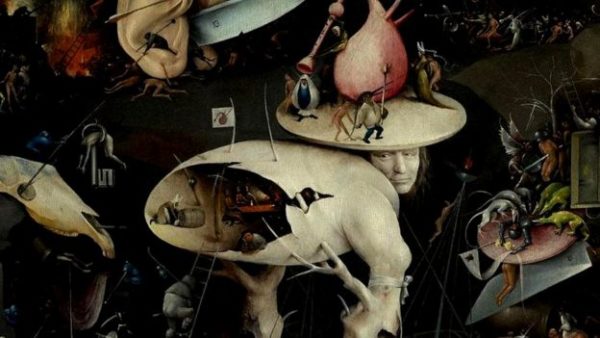
It is also known as The Musical Hell, for the multiple representations of musical instruments that appear. Why Bosco associates music with sin is unknown. He has painted the torments of hell, to which Humanity is exposed. It describes a dreamlike, demonic, oppressive world of innumerable torments. It is a very somber table in relation to the color of the other two: livid tones of the hell of ice, vivid flames of the hell of fire. The table can be divided into three levels:
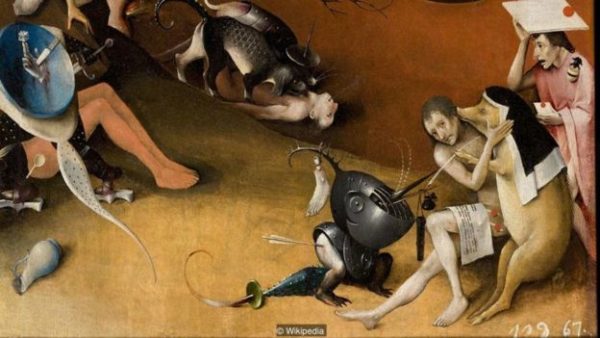 On the upper level you can see the typical image of hell, with fire and torture. The architectures are mired in strange phosphorescent lighting. That fire, which really represents the night landscape of a burning city, has been linked to a trauma of the painter, who saw when he was a child how his hometown was grazed by fire. Certainly, these representations of burning cities can be seen in other paintings by the author. The atmosphere is totally demonic. Criticism seems to agree that the knife attached to the two ears is a male genitalia, while the bagpipes that a monster holds over its head could be a homosexual or, perhaps, female element.
On the upper level you can see the typical image of hell, with fire and torture. The architectures are mired in strange phosphorescent lighting. That fire, which really represents the night landscape of a burning city, has been linked to a trauma of the painter, who saw when he was a child how his hometown was grazed by fire. Certainly, these representations of burning cities can be seen in other paintings by the author. The atmosphere is totally demonic. Criticism seems to agree that the knife attached to the two ears is a male genitalia, while the bagpipes that a monster holds over its head could be a homosexual or, perhaps, female element.
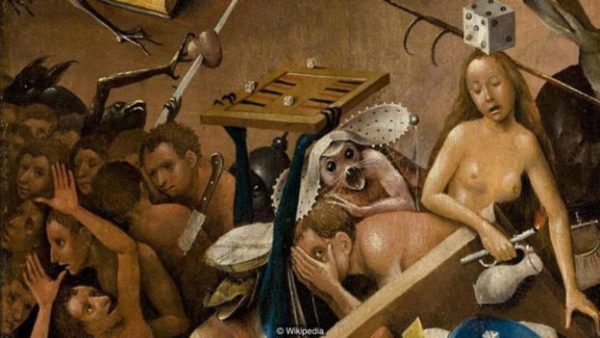
In the central part, a dream world appears, with fantastic creatures, and whose central figure in a “tree-man”, also known by an autograph drawing from the Albertina Museum in Vienna. Look directly at the viewer. It has been interpreted on numerous occasions as the face of the artist himself and that with an awkward bandage he tries to hide a sore caused by syphilis. On his head is a d
isc, in which little monsters dance with a large bagpipe with the alembic aspect. Their arms are like tree trunks and they are resting on boats. Its thorax is open and h
ollow like an eggshell, and inside it are more beings. Beneath it is a frozen lake, on which some condemned men skate, while the ice breaks. In the Middle Ages the contrast between cold and heat was considered one of the tortures of hell. Highlights a character with the head of a raptor sitting on a toilet, and with a kettle on his head. It is thought that it could be Satan devouring the damned and defecating them in a cesspool in which other characters vomit filth or excrete gold, the latter perhaps as an allusion to greed. Under Satan’s cloak a naked woman is forced to look at herself in a convex mirror placed on the buttocks of a demon, alluding to the sin of pride.
At the bottom left is a group of players (there are dice, cards, backgammon board, a naked woman carrying a jug) tormented and tortured by demons in the midst of great chaos, all of which alludes to laziness, lust, and gluttony. On the right, a man is seen hugged by a nun-veiled pig, probably alluding to lust.
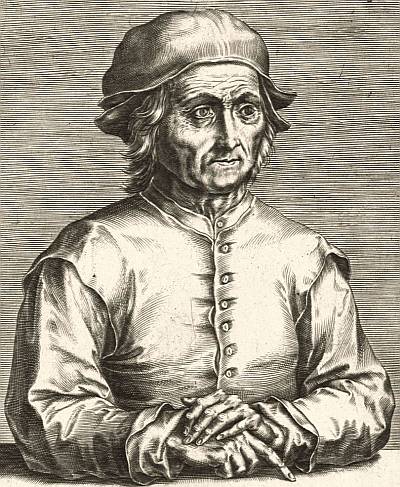
Jheronimus van Aken
Known as Jheronimus Bosch or Hieronymus Bosch (Bolduque, c. 1450-1516)
